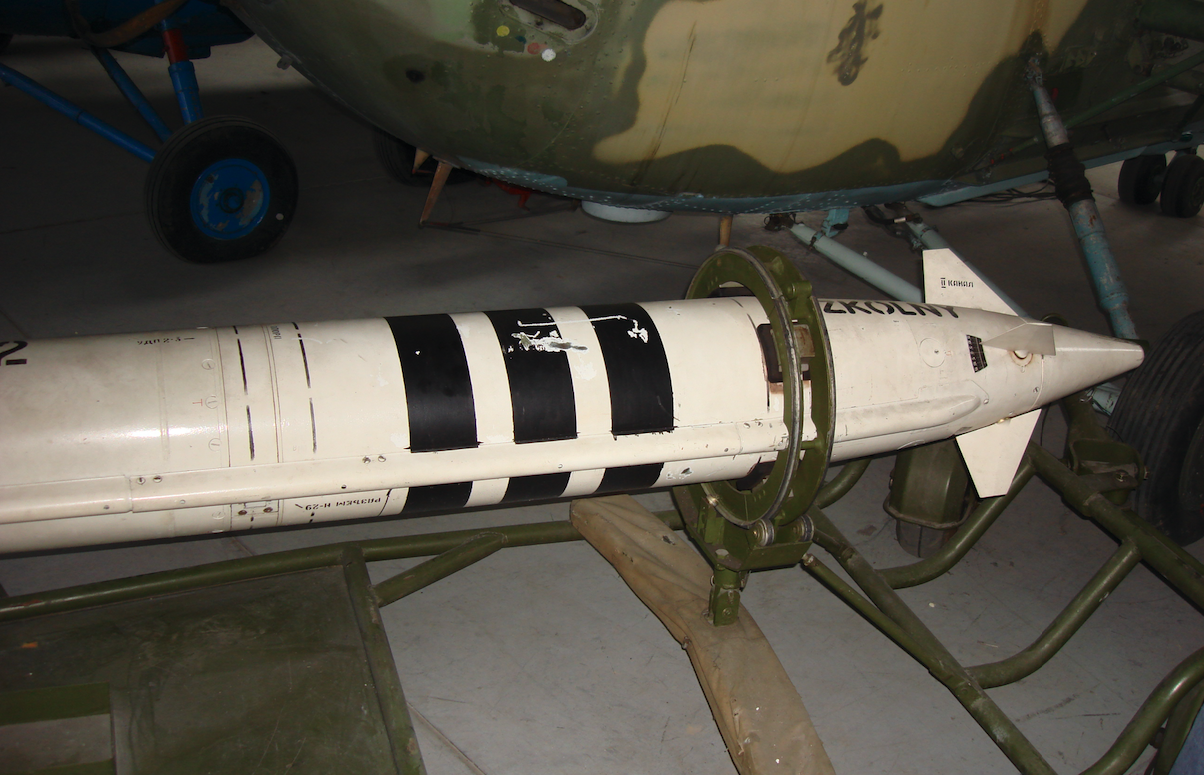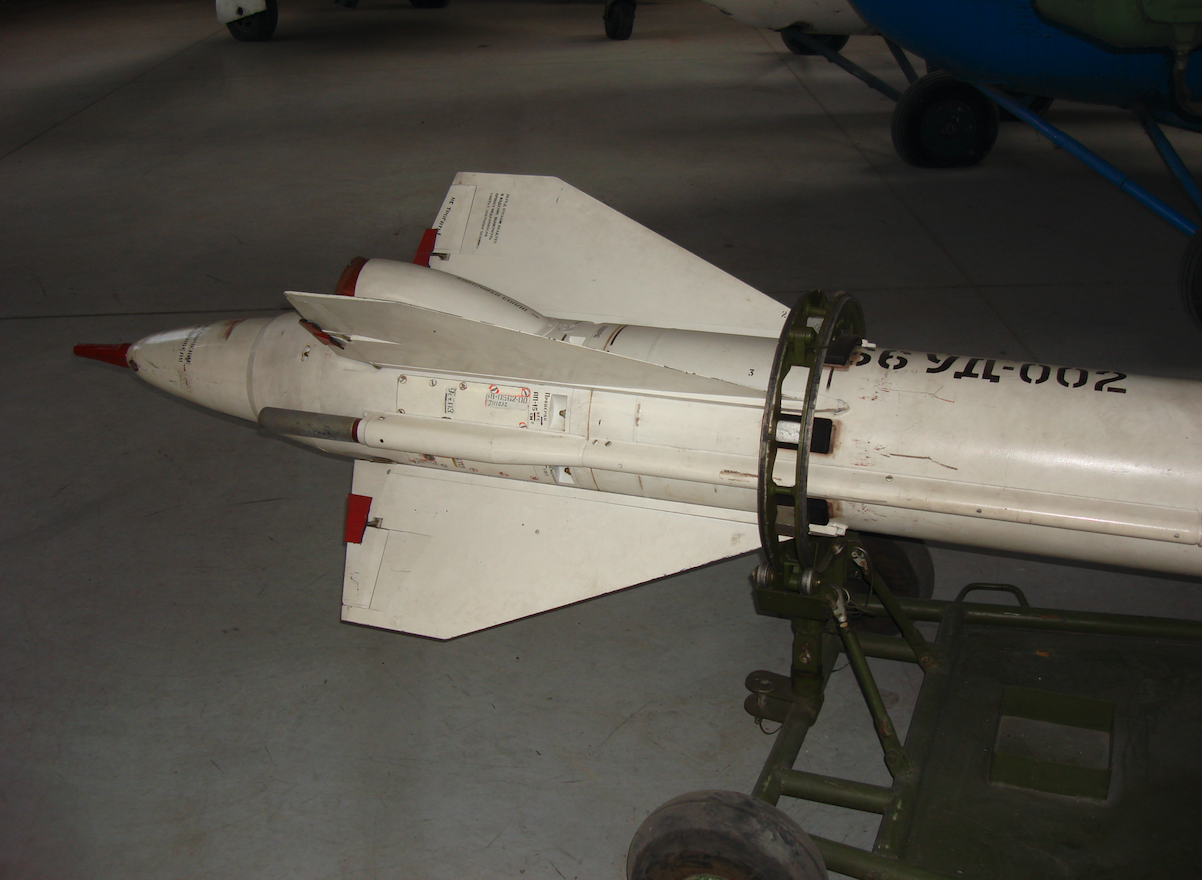Kraków 2020-10-14
Ch-66 guided missile.



The history of the Ch-66 missile.
When the RS-2US missiles were introduced in the CCCP, the idea was to use these missiles against ground or surface targets. Such use was favored by the missile guidance system used, i.e. guidance in the radio beam emitted by the plane's radar. The MiG-19 PM aircraft, equipped with four RS-2US missiles, were tested. Although the missiles hit the targets well, the effect of their use was low due to the low weight of the warhead. The work was stopped.
But in the US and France, work on guided missiles to tackle ground targets was continued. In the USA, AGM-12 Bullpup missiles were introduced into service, and in France, AS-20 and AS-30 missiles from Nord Aviation.
In 1965, as a result of reports from Vietnam, the CCCP resumed work on this type of missile due to the high effectiveness of the AGM-12 Bullpup missiles. The OKB Wympieł office was tasked with developing the Ch-23 missile for the MiG-23 aircraft under construction at that time. Because the missile was also to be used by the existing frontline planes: MiG-19 and MiG-21. Therefore, it was decided to develop a new missile based on the RS-2US design, which was designated Ch-66.
Work on the new Ch-66 missile began in 1966. It was assumed that the weight of the warhead was about 100 kg. The engine was taken from the R-8 rocket used on the Su-11 aircraft. The control system was taken from the RS-2US missile.
The steering system is based on the RP-21 radar sight, which is installed in the aircraft. The missile is guided by the three-point method using lines of equal signals from the radar guide beam. The radar works in the range of a blocked cone beam. The beam is created by the constant rotation of the antenna's directional pattern, i.e. the so-called cone search. (Exactly the same as with the RS-2US missile). During the attack, the pilot always has a target on the reticle, and the missile follows the radar beam, correcting its flight path.
Explanation: The Ch-66 missile was not used with the RP-22 Sapfire radar because these radars work on a different basis.
Field tests of the Ch-66 missile showed that when the carrier dives at an angle of 10-30 degrees, from a distance of 6,000 - 4,000 m, the missile hits a circle with a diameter of 25 m, with a 90 percent probability of destroying the target.
The drawback of using the Ch-66 missiles was the lack of ground target detection systems on board the MiG-21 aircraft. The pilot had to visually detect the target. In fact, the pilot was detecting a target that was to the side of the plane's course. Simultaneous attack with target detection and rocket launch was practically impossible. The accuracy of the attack depended on the weather conditions, target size and pilot experience.
The Ch-66 missile was adopted by the CCCP in 1968.
Description of the Ch-66 missile.
The missile's aerodynamic system and components are the same as in the RS-2US missile. Projectile weight is 278 kg. Projectile length 3.63 m. Projectile diameter 0.27 m. Wingspan 0.81 m. The maximum speed of the projectile is 2 Ma. Projectile speed 600 - 650 m / s.
Host flight parameters. Speed in the range 600 - 1,100 km / h. The flight altitude is 1,000 - 5,000 m. Firing distance 3,000 - 10,000 m. Recommended firing distance 4,000 - 6,000 m.
The high-explosive-high-explosive combat warhead weighs 105 kg. The mass of the TG-40's propellant is 51 kg. Detonation occurs via an electromechanical, immediate-acting impact fuse. The projectile penetrates armor with a thickness of 250 mm. Hits unarmored targets within a 20 m radius.
Solid rocket engine. The fuel is nitroglycerin powder, in the form of one stick.
Ch-66 missile in Poland.
The Ch-66 missiles went to Poland together with the MiG-21 M and MiG-21 MF planes, which have RP-21MA radar sights. Ch-66 missiles were used in the 4th Fighter Aviation Division (41st PLM Malbork, 9th PLM Debrzno, 2nd PLM Goleniów). The 4th Division was first in favor of fighting air targets, and secondly attacking ground targets. The introduction of the Ch-66 missiles increased the efficiency of the regiments in the second task. Interestingly, the basic attack aircraft at that time was the Su-7, but this aircraft was never armed with guided air-to-ground missiles. Therefore, the MiG-21 with the Ch-66 missiles was valued higher than the Su-7.
MiG-21 M and MiG-21 MF planes took two Ch-66 missiles under the wings, on internal hooks, on APU-68UE launchers. The APU-68UE launchers are also used for the RS-2US and S-24 missiles (unguided). Ch-66 missiles are fired individually or in a volley with a small time delay so that the missiles do not collide in flight.
In Poland, MiG-23 planes did not carry Ch-66 missiles.
In Poland, the Ch-66 missiles were used until 1990, when the Su-22 planes began to play a major role in attacking ground targets.
Written by Karol Placha Hetman
